EDWARDS, Oliver and Henrietta Muir Edwards, and Family
Dr. Oliver Cromwell Edwards (1859-1915) lived at Indian Head in 1882-83 and visited the Bell Farm regularly. He came to the West in 1882 and over the next decade acquired periodic government employment as Medical Officer for the Treaty 4 region, providing medical service to the First Nation peoples living in the Fort Qu'Appelle - Indian Head - Qu'Appelle region.
In 1883 his wife Henrietta Muir Edwards (1849-1931) and their two children, Alice and William, joined him. Their third child, Margaret, was born at Indian Head in the midst of the North-West Rebellion of 1885. The Edwards were reportedly frequent visitors at the Bell Farm.
Throughout the 1880s Dr. Edwards regularly reported on the difficulties that the First Nations people faced with respect to a lack of food and inadequate health care. However, his reports, like similar ones from other sources, were basically ignored by officials in Ottawa. Some suggest that his Liberal political support hindered his ability to influence the Conservative government of the day, and to gain more regular medical appointments. His later appointments by the Liberal Government would, in part, seem to corroborate this statement.
The family lived in the Fort Qu'Appelle, Indian Head, Regina and Qu'Appelle regions during the 1880s, and later in Eastern and Western Canada. Dr. Edwards’ medical career was not lucrative, and Henrietta often supplanted family income from her own resources.
In addition to caring for her family, Henrietta collected aboriginal art and became an accomplished artist in her own right. The sale of her art helped sustain the family's income. In the late 1880s she also took up the cause of women's rights. Henrietta became even more socially and politically influential after their move to Ottawa in 1890 and later to southern Alberta. She was one of "The Famous Five" Alberta women who espoused women's suffrage in the early 20th century and secured the right of women to vote and hold elected office. Their fight to have women declared as legal "persons" was confirmed by the British Privy Council in 1929. Henrietta was also the co-founder, with Lady Aberdeen, of the National Council of Women and the Victorian Order of Nurses.
For her various contributions, Henrietta Edwards was recognized in 1962 by the Historic Sites and Monuments Board of Canada as a person of national historic significance. Larger-than-life bronze statues of The Famous Five can be seen in downtown Calgary.
Dr. Oliver Edwards died in 1915; Henrietta Muir Edwards died in 1931.
SOURCES:
"Wineglass Ranch" website: http://www.wineglassranch.ca/family-heritage/dr-oliver-c-edwards
"Montreal Medical Journal" – Oct. 1883, page 190: https://archive.org/stream/montrealmedicalj12mont#page/190/mode/2up
Dr. Edwards at Indian Head: https://archive.org/stream/honalexandermac00rossgoog#page/n614/mode/2up
Dr. Edwards obituary: April 22, 1915, "Ottawa Journal"
Dr. Edwards treats British Association tour member Burton – accident: Aug. 18, 1884 - "Winnipeg Free Press"
M.A. Thesis, U of Calgary, 1975 (p. 103 & 108, 109): "Henrietta Muir Edwards: the journey of a Canadian feminist" by Patricia Roome:
http://www.collectionscanada.gc.ca/obj/s4/f2/dsk3/ftp04/nq24346.pdfEdwards Family photo, ca. 1882-83 (L-R: Doctor Oliver C. Edwards; Alice (in chair, foreground); Mrs. Henrietta Muir Edwards; Amelia Muir; Willie (asleep); Willie Edwards:
http://www.glenbow.org/collections/search/findingAids/archhtm/edwards_gardiner.cfm#series13Glenbow Archives Collection:
http://www.glenbow.org/collections/search/findingAids/archhtm/edwards_gardiner.cfm#series1"The Banker and the Blackfoot", by J. Edward Chamberlin
RESEARCH BY:
Michelle Cabana, Saskatoon; Margaret Hryniuk, Regina; Bill Armstrong, Regina; and Frank Korvemaker, Regina, Saskatchewan

